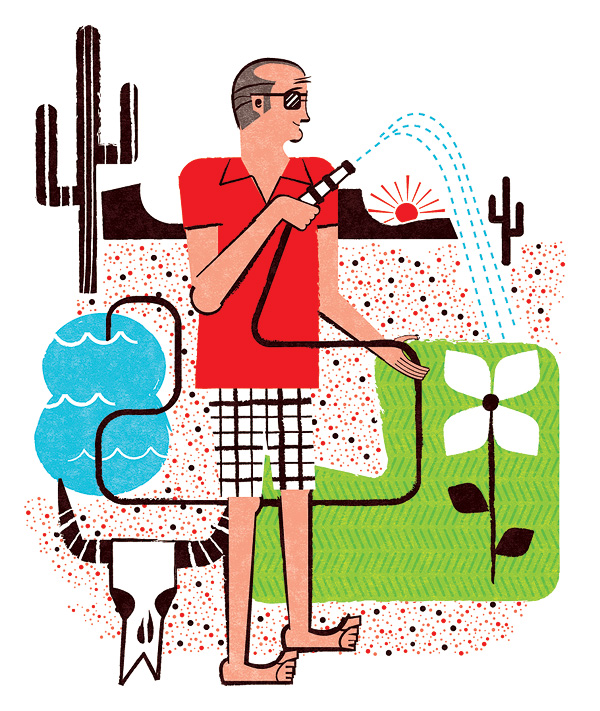Each week, the University of Nebraska’s U.S. Drought Monitor publishes a map delineating the most parched parts of the country. Each week, I have watched the maroon color indicating the most severe of the four drought stages—termed “exceptional”—creep across the state, eventually laying siege to North Texas. For the better part of the summer, it looked as though we might be okay, remaining in stage two, “severe” drought, but then the unrelenting heat wave sent us into stage three, “extreme.” The city of Dallas sprang into action. It asked residents to water their lawns only twice a week. Pretty please with sugar on top.
A bit of background: unlike most Sun Belt cities, Dallas (and its burbs) has sufficient water to support its current population, thanks to all the reservoirs dug and dammed around North Texas. Of the five largest Texas cities, Dallas uses the most water per capita. San Antonio, with nearly the same population, uses 30 percent less. If you have cash in your pocket, you’re going to spend it, right? The EPA estimates that a third of all residential water use goes toward lawn irrigation. Other studies have placed that number as high as 50 percent. A NASA study estimated that maintaining our lawns, on average, requires 200 gallons per person per day. Only about half of that water actually makes it into the ground. The rest is lost to evaporation and runoff. The latter picks up lawn care chemicals and carries them to our streams and, eventually, to our reservoirs. One common herbicide, 2,4-Dichlorophenoxyacetic acid, is an ingredient in Agent Orange.
We’d do better just to run our hoses directly into the street. We’d still waste just as much water, but at least we wouldn’t be poisoning ourselves.
The lawn as we know it is a uniquely American creation. We borrowed the concept from European aristocracy, who used it to signify wealth. Only a rich person could afford acres of fruitless land and the staff to maintain it. In some cases, that’s true today in Dallas (see: Tom Hicks, whose 25 acres require some 10 million gallons per annum). More often, though, it’s the breadwinners themselves who slave over those manicured emerald expanses. In Texas, that’s typically Bermuda grass (St. Augustine, if you’ve got a bit more shade). Its name might belie its African origins but not its needs as a tropical and subtropical species: direct sun and lots of rain. Or, in the absence of rain, irrigation.
Water is the most important variable in the equation that describes urban growth and development—or the lack thereof. Imagine what would happen if Texas Instruments, Dallas’ biggest commercial water user, couldn’t get the water it needs. If you were to place water within Abraham Maslow’s pyramidal hierarchy of needs, it would be the foundation. By watering our lawns, we’re giving away our most precious resource.
The most current estimate for our area of the state (2011’s Region C Water Plan) has demand for water beginning to outstrip supply within the next 10 years, thus putting us in the company of the rest of the thirsty Sun Belt. No more cash in the wallet. Time to get serious about conservation. There are regional initiatives we can institute, such as improving riparian watersheds to slow and treat the flow of water. But given the sheer amount of water used to keep our lawns green, it makes more sense to cut back on the least productive use of that resource.
Telling people what to do doesn’t work. We’ll never achieve sustainability through nagging. As D Magazine was going to press in late August, Dallas City Manager Mary Suhm proposed raising water rates by about 6 percent. But that hike would cover only improvements to treatment plants. If you paid, say, $400 last month to keep your yard green, another $24 won’t make much difference. To reach sustainability, the city should do two things: first, raise rates for residential customers to a level right below the point that would incite armed revolt. Second, Dallas should follow the lead of El Paso and Austin and pay residents to rip up their turf. Even if homeowners can’t be persuaded to xeriscape with gravel and desert plants, higher water rates might lead them to do what Richland College did, which is replace its old turf with the less thirsty, native buffalo grass. Sure, the ultrarich will always flaunt their green Bermuda, but the rest of us can learn to love buffalo.
Write to [email protected].






